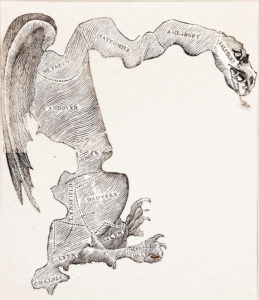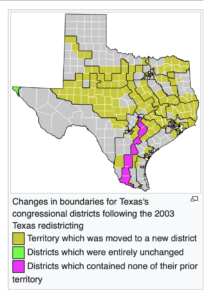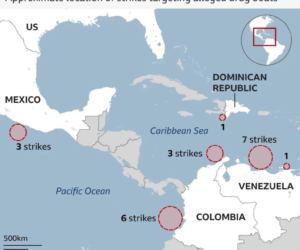
News organizations are providing zero context for the mid-decade Texas legislature redistricting power grab, using the pejorative method known as gerrymandering since 1812.
Media fail to mention that the Texas legislation did this after the 2000 census. Democrats fled the state then, too, to try to deny a legislative quorum. They failed and Republicans achieved a “majority of Texas’s federal House seats for the first time since Reconstruction.”
Should the unicorn story claim a move such as that in Texas is “rare” or “not common” there is no source nor further explanation for the claim. So, I went looking.
What does the Constitution say about redistricting?
Every 10 years, the U.S. Census documents every person living in the United States, regardless of their right to vote. It’s been that way since the beginning.
Afterwards, Congress does the math to see which states gain new US Representatives and which lose them, with the total fixed at 435 since 1929. (That’s a topic for another day.)
Article I, Section 2, Clause 3.1. Enumeration Clause and Apportioning Seats in the House of Representatives:
…The actual Enumeration shall be made within three Years after the first Meeting of the Congress of the United States, and within every subsequent Term of ten Years, in such Manner as they shall by Law direct (emphasis added)…
The states then draw new congressional and state legislative district maps (redistricting) that are supposed to conform to state law and the federal Voting Rights Act, which this US Supreme Court continues to weaken. Partisan gerrymandering? Off the SCOTUS table, onto the state court docket.
The Supreme Court, in a 2019 case originating from North Carolina, ruled that federal courts have no authority to decide whether partisan gerrymandering goes too far. Chief Justice John Roberts wrote: “The Constitution supplies no objective measure for assessing whether a districting map treats a political party fairly.”

What does “rare” mid-decade redistricting mean?
In 2002, Texas Republicans captured the state legislature for the first time since Reconstruction. In 2003 the legislature drew a new congressional map for political gain after the official post-census redistricting. The congressional delegation composition flipped from 17-15 Democratic to a 21-11 Republican blowout.
It was the first Republican congressional delegation in Texas since Reconstruction. Moreover, in 2006 the SCOTUS and appeals courts upheld the mid-decade map and its mid-decade birth. The SCOTUS ruled that one district violated the Voting Rights Act. The adjustment did not negatively impact the Texas GOP.
Georgia did the same thing after the 2004 election flipped the state legislature to the GOP. Unlike in Texas, judges struck down the Georgia congressional map as violating the “one person, one vote” rule.
Mid-decade redistricting for political gain — gerrymandering — is damn rare. It’s so rare that these two states should be mentioned when discussing any 2025 mid-decade discretionary map revision.
Other instances of states redrawing their initially approved congressional maps mid-decade have come after losses in court. In other words, courts mandated the maps be redrawn in these states because they did not meet the requirements of the Voting Rights Act or their own state laws. Mandated, not a partisan power grab.
Voting Rights Act violations
Alabama
In 2023, the SCOTUS ruled that congressional map developed by the Republican-led legislature diluted the voting strength of Black residents and required the map be redrawn. New map implemented.
On May 8, 2025, the court ruled that the 2023 map, like the 2021 map, ran afoul of Section 2 of the Voting Rights Act by limiting Black voters’ opportunity to elect candidates to one district. In addition, the court ruled that the Alabama legislature intentionally discriminated against Black voters when it adopted the 2023 map.
Georgia
In 2023, plaintiffs contended the congressional map developed by the Republican-led legislature diluted the voting strength of Black residents and required the map be redrawn. Still under litigation in the Eleventh Circuit Court of Appeals.
Louisiana
In 2023, the Fifth Circuit Court of Appeals ruled that congressional map developed by the Republican-led legislature diluted the voting strength of Black residents and required the map be redrawn. The legislature did this in 2024. White voters appealed on gerrymandering claims. This case is now before the SCOTUS for the 2025-2026 term.
Texas
Multiple lawsuits claimed that the Congressional map the Republican legislature drew after the 2020 census was either a racial gerrymander or violation of the Voting Rights Act. The court held a trial in May and June 2025 but has not ruled.
Other violations
Florida
In 2015, the Florida state Supreme Court ruled the legislatively-drawn congressional map violated the state constitution. The Republican legislature’s inability to redraw the map led to judicial intervention.
Maryland
The trial court ruled the map be redrawn due to extreme partisan gerrymandering by the Democratic legislature that violated the state constitution. The map was redrawn in 2022 and survived additional litigation.
New York
After the 2020 census, a trial court ruled the new maps violated procedural rules and displayed partisan gerrymandering. The trial court ordered a new map.
North Carolina
The Republican legislature began drawing extreme gerrymandered districts after the 2010 census. Litigation and court ordered revisions followed. In 2023, the state Supreme Court ruled gerrymandering was not a legal cause to challenge Congressional maps after it flipped from Democratic to Republican majority.
Pennsylvania
The 2011 congressional map was ranked as “one of the top three starkest partisan gerrymanders in the country.” The Public Interest Law Center successfully challenged the Republican-drawn map in state court; a new map graced the 2018 elections. Yes, almost in time for a new census map.
Ohio
In 2022, the court ruled the Republican congressional map resulted in partisan gerrymandering contrary to the state constitution. Plaintiffs withdrew their lawsuits after the SCOTUS returned the cases to the state.
Despite the court’s order, Ohio took no steps to redraw the state’s congressional map and instead asked the U.S. Supreme Court to hold that the federal constitution’s Elections Clause barred state courts from ruling on state-law claims relating to congressional maps.
South Carolina
In 2024, the South Carolina League of Women Voters filed suit contending the Congressional map drawn by the Republican legislature was a political gerrymander. The state Supreme Court has yet to rule.
Virginia
After the 2010 census, the Republican governor and legislature redrew the Congressional map. However, in 2016, a federal court ordered the legislature to redraw five of the eleven districts because of racial gerrymandering.
The state of partisan gerrymandering in the United States
Most states delegate congressional redistricting to their legislatures.
A few have independent, non-partisan commissions manage redistricting. A few prohibit legislatures from gerrymandering in their constitutions. These include:
- Alaska – state court interpretation of constitution
- Arizona – independent commission
- California – independent commission
- Colorado – constitutional amendment
- Florida – constitutional amendment
- Michigan – independent commission
- Missouri – constitutional amendment
- New York – independent commission and constitution
- Ohio – constitutional amendment
- Pennsylvania – constitution
- Washington – independent commission
Since the SCOTUS decision in a North Carolina case in 2018, state courts have become increasingly involved in litigating congressional maps.
This tidbit from Democracy Docket is upsetting but not surprising in a polarized world:
A recent review of state-level partisan gerrymandering cases by several prominent redistricting scholars confirms this trend. In eight cases decided between the 2020 and 2022 elections, more than 95% of justices voted to overturn maps drawn by legislatures of the opposite party, while only a third voted to overturn maps drawn by their own party.
The Texas initiative has led to a plethora of red and blue state leaders stating they will possibly pursue redrawing their congressional maps mid-decade as well. Such a quid pro quo would disenfranchise wide swaths of voters of the opposition party, thus putting American democracy on even shakier ground. Nevertheless, Democrats are spinning the story that their actions are not quid pro quo.
“What [Texas Gov.] Greg Abbott is doing and what [President] Donald Trump is attempting to do is to cheat mid-decade here. They’re attempting to change the map,” [Illinois Gov. JB] Pritzker told NBC’s Kristen Welker in an interview that aired Sunday on “Meet the Press.” “They know that they’re going to lose in 2026, the Congress, and so they’re trying to steal seats. And so that is what these Texas Democrats are trying to stand up against…
“You talked about how rare it is to do what he’s doing. Yes, it is. What’s even rarer is to do it at the behest of the president of the United States, who’s clearly attempting to and says that he deserves to have five more seats…
“When Barack Obama was president, when Joe Biden was president, did either of those presidents call a governor of a state or a state legislature and tell them to gerrymander to find five seats for them? No,” [Eric] said. “So we’re doing something now that is responsive to what is going on with this White House…
“That call to Texas is kind of reminiscent of the call that President Trump made to the secretary of state in Georgia,” Holder told Welker. “He said, ‘Find me 11,780 votes.’ He calls Texas now and says, ‘Well, find me five seats so that we can save the House in 2026.’”
Updated at 12:45 pm Pacific
Known for gnawing at complex questions like a terrier with a bone. Digital evangelist, writer, teacher. Transplanted Southerner; teach newbies to ride motorcycles. @kegill (Twitter and Mastodon.social); wiredpen.com
















